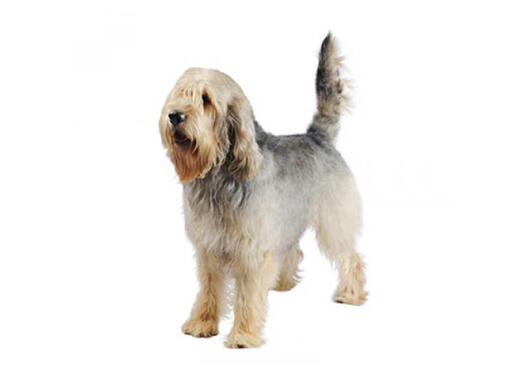
An English scenthound bred to hunt otter on land and water, the Otterhound is distinguished by his shaggy, rough coat and webbed feet. His large, robust body and deep, powerful voice make him an excellent watchdog. Lively and good-natured, this dog is a devoted family companion. The Otterhound requires frequent weekly grooming to prevent matting in his coarse, dense coat.
DID YOU KNOW? The Otterhound is a rare breed. There are less than 1,000 Otterhounds worldwide.
The need-to-know
- Dog suitable for experienced owners
- Some training required
- Enjoys active walks
- Enjoys walking one to two hours a day
- Large dog
- Minimum drool
- Requires grooming every other day
- Non hypoallergenic breed
- Chatty and vocal dog
- Not a guard dog
- May require training to live with other pets
- Great family dog
Personality

The Otterhound is a friendly, good natured dog with a sense of humour and fun. They are also a large dog in every sense of the term, tall, long, well built and shaggy coated. They can be exuberant and boisterous, and as with all scent hounds, are inclined to switch their ears off once their nose is engaged.
History and Origins

Country of Origin: England
Originally bred to hunt otters in order to protect fish stocks in ponds, this strong bodied large hound is ideally built to work in water for hours on end. This is an ancient breed and the earliest records of otter hunting with hounds’ date back to the reign of Henry II in the 12th century. In those days the breed was much more like a terrier than a hound and it was several centuries until the terrier influence was bred out in favour of the large hound we know today.
Nutrition and Feeding

Large breed dogs, as well as having large appetites, benefit from a different balance of nutrients including minerals and vitamins compared to smaller-breed dogs. The Otterhound can be prone to bloating and stomach problems; smaller, more frequent meals can help minimise this risk.
Exercise

When young, the Otterhound’s exercise should be carefully limited so that they do not over-exert themselves or damage growing joints. All Otterhounds adore water, and will follow a scent to the ends of the earth. Otterhounds enjoy exercise, but it is the variety of scent and scenery that is more important to them than the speed or distance covered. A mixture of walking, paddling, swimming and sniffing will meet their needs better than a couple of hours running alongside a bike or jogging partner. Allow two hours per day exercise for the adult Otterhound.
Other Information

Health and common issues
As with many breeds, the Otterhound can suffer from hip and elbow dysplasia (joint conditions that can be painful and lead to mobility problems). Hip scoring of dogs prior to breeding is therefore important. The breed club monitor the health of the breed carefully and should be contacted for the most up-to-date information and details of any DNA or additional testing they recommend. Breed Clubs can be found on the Kennel Club website.
Space requirements
This is a big dog, and while there are taller dogs and heavier dogs, the Otterhound combines significant height, length and weight with a rough, debris collecting coat, water and drool dropping flews, and ears that dangle into food and water bowls. You will need a spacious home, with room to let a wet hound dry off, space to groom them and a secure garden with at least 6ft fencing that cannot be jumped over, squeezed through or dug under. Access to countryside walks and suitable paddling and swimming locations would be ideal. Not suited to city living.
Training otterhound
Early and consistent training on recall and in the use of a longline and harness are vital, as like most scent hounds, the Otterhound goes deaf when following a trail. Due to their size and a coat that picks up water and mud, it’s sensible to train your Otterhound to stand to be dried off and brushed through, and to lie down quietly wherever they are asked. Although not a dog who enjoys training for trainings sake, Otterhounds are ideal for those interested in tracking, man-trailing and other scent related sports and competition.
Best family dog breeds
Otterhounds can make a fun and active pet for the right family, however they are large and boisterous which may cause problems with smaller children or older family members. Their preferred exercise involves being outside in the water or in horrid weather so take this into consideration, not all family members may enjoy such walks! While many dogs are traditionally thought of as being good with children, all dogs and children need to be taught to get on with and respect each other, and be safe together. Even so, dogs and young children should never be left alone together and adults should supervise all interactions between them.
Did you know?
- Otterhounds stopped hunting otter in 1978, as otters were rare and gained protected species status.
- The Otterhound is now endangered and are thought to be rarer than the giant panda. They are on the UK’s vulnerable breeds list with less than 50 puppies registered per year for the last 5 years.
- Otterhounds have an odd way of drinking, submerging their whole nose under water at times, blowing bubbles and spreading the water quite some distance!
- They have large, webbed feet to help them swim.
- They’re known to be quite vocal and have a deep ‘bay’ which carries over long distances.